If you love pork, you must try this kakuni (角煮, simmered pork belly). The pork is cooked slowly so it is tender and it has a lovely sweet soy sauce flavour, but it does not over power the flavour of pork. Though it requires patience to cook slowly, this is very easy to make.
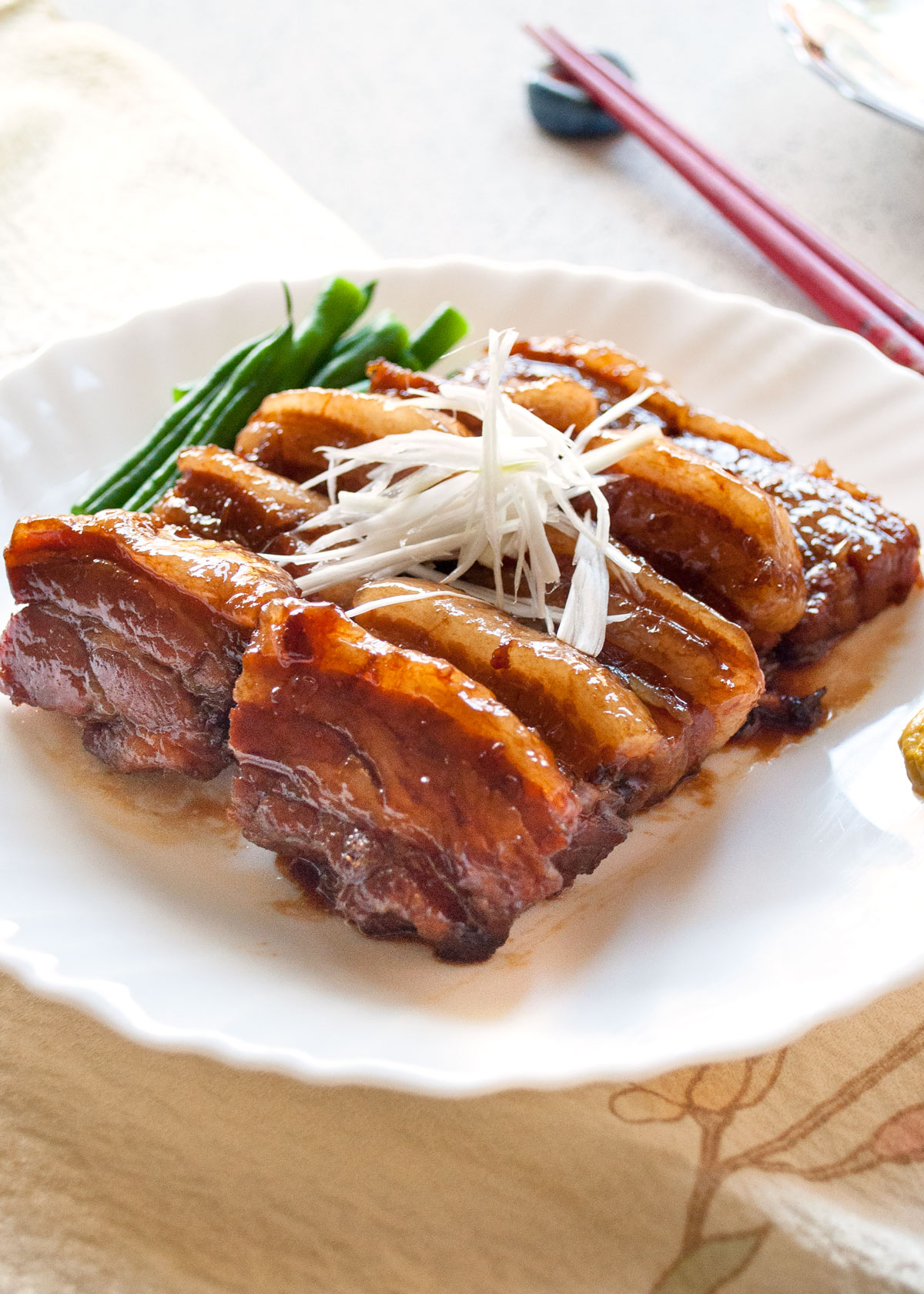
Some say that kakuni came from China during the time when Japan was closed to most of the outside world. At the time, the only port city where foreign ships had access to was Nagasaki and the Chinese dish called Dongpo Pork was introduced to Nagasaki. Over the years, it was modified to the Japanese palette and evolved to became kakuni.
Kaku (角) comes from the word kakugiri (角切り) which means ‘cut into cubes/square’ and ni (煮) comes from the word niru (煮る) which means to simmer/cook in liquid. So the name kakuni does not imply or mean “pork” but if you say kakuni, it has to be made with pork belly.
Pork belly has a lot of fat but that’s where all the flavour is. However, by cooking the pork belly for a long time, much of the fat melts away and the fat that remains is really tender so the finished dish does not taste fatty.
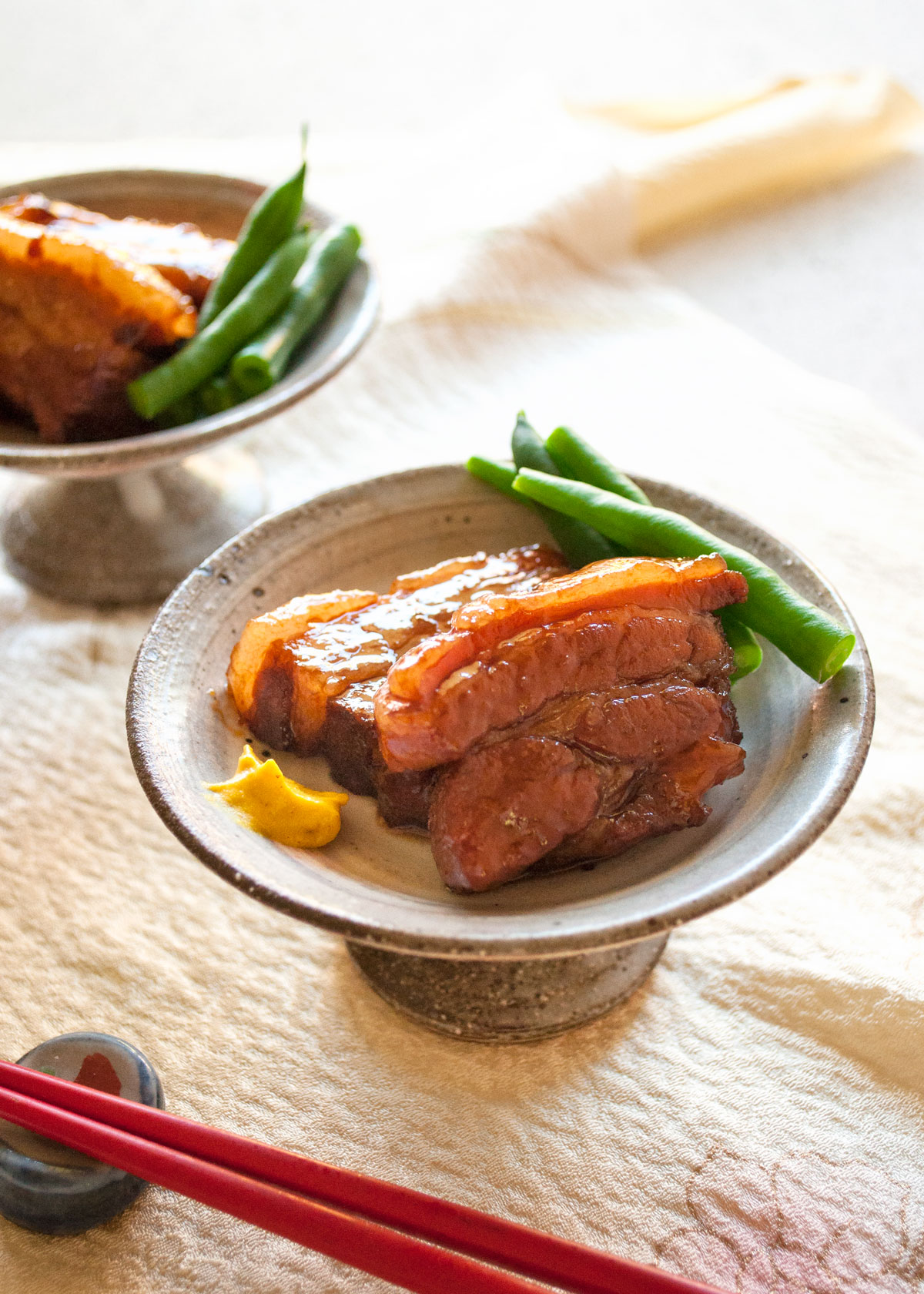
Kakuni is simple to make with only common Japanese seasonings. Time is the only restricting factor if you are in a hurry because it will take almost 3 hours to cook in a normal pot. But if you use a pressure cooker, you can shorten the cooking time significantly.
Some kakuni recipes brown the meat cubes in a fry pan first before simmering them in the braising liquid. But I don’t, probably because I used to mostly cook kakuni in a pressure cooker where I threw everything in a pot and just cooked after quickly blanching the meat.
Some recipes have boiled eggs added into the braising liquid towards the end. The surface of the egg gets stained brown and looks quite dramatic when served cut in half – imagine the yellow yolk and the egg whites outlined in brown. To come to think of it, I don’t think I have ever served eggs with kakuni which is surprising given that my youngest daughter loves eggs and asks for eggs to be added to everything!
Kakuni is usually served as a main dish but it can also be served as an appetiser/starter with just a couple of pieces per serving. In my photos, you can see the dish served as a main meal on a white plate as well as an appetiser on two little plates with stand.
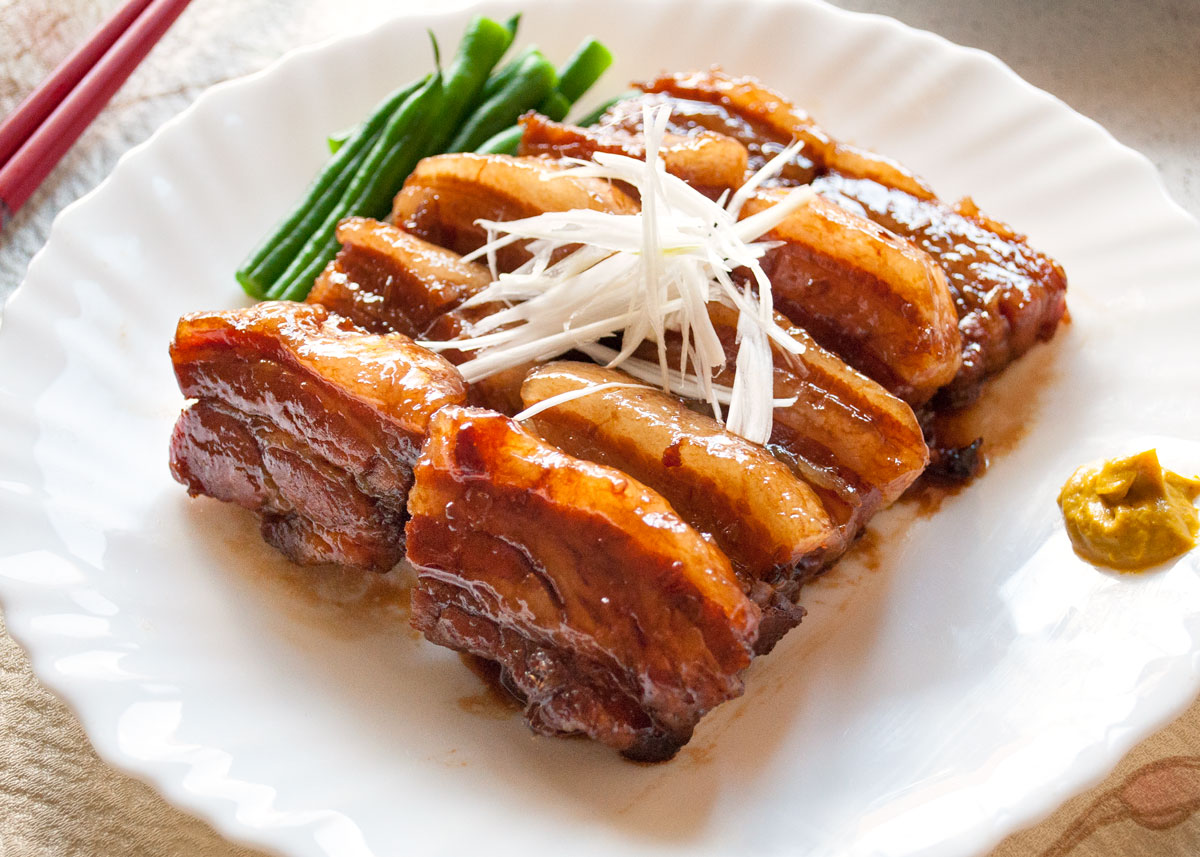
It is traditional to serve kakuni with a drop of Japanese mustard called karashi (辛子 or からし). Karashi is a bit darker yellow than most other mustard. It does not have acidity in it and very hot. It is perhaps closest to hot English mustard.
You can buy karashi at Japanese/Asian grocery stores. They come either as paste in a tube or powder in a small tin. The tube version seems to be more widely available. Karashi in a tube looks like this.
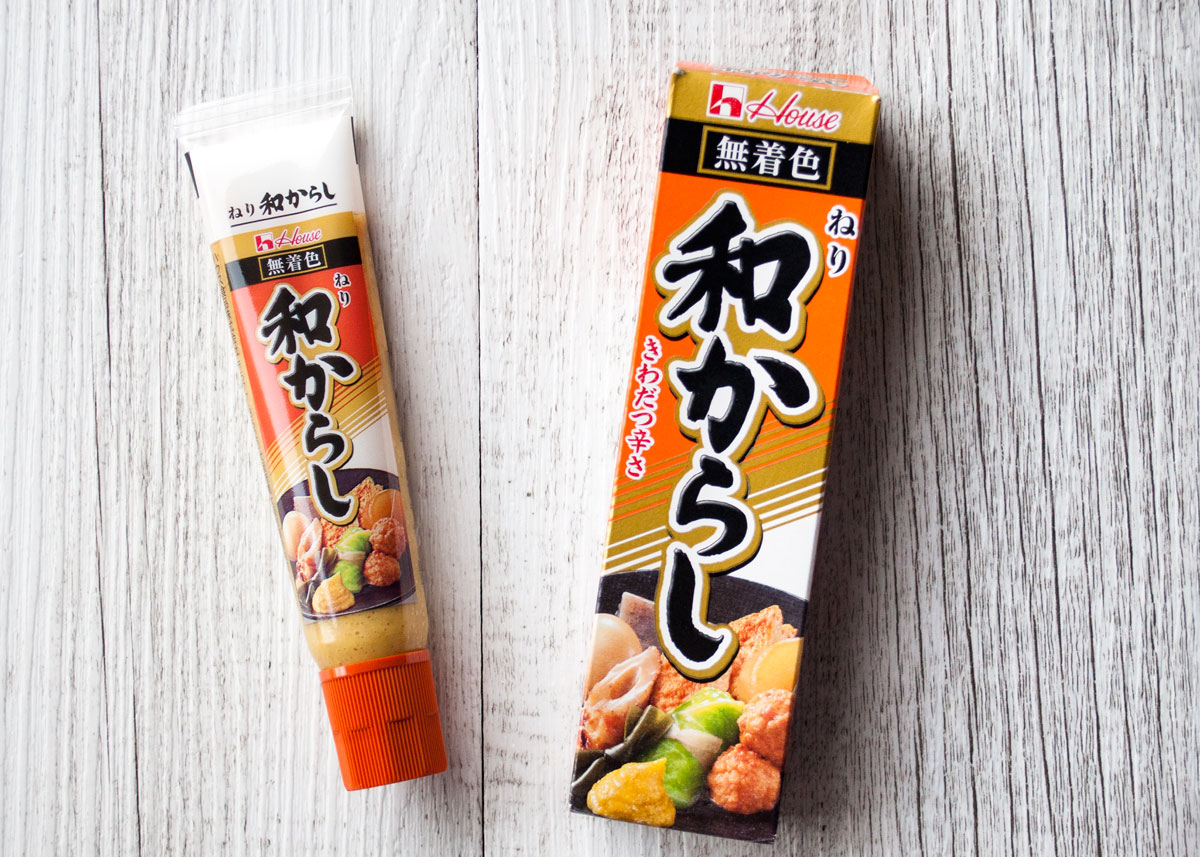
If you happen to get karashi in powder form, you just mix the powder with warm water in a little bowl to make a paste, then cover and leave it for a while to develop spiciness.
I ran out of karashi so I used hot English mustard this time and it was OK. American mustard does not go as well due to strong acidity.
Unlike most of my Japanese dishes, you might find that kakuni has rather strong soy sauce flavour. My son commented about it saying that the flavour is strong, unlike my usual dishes. But it has to be strong flavoured, otherwise it won’t be kakuni. If your palette is on a sweet side, you could increase the amount of sugar by ½ tablespoon.
Yumiko![]()
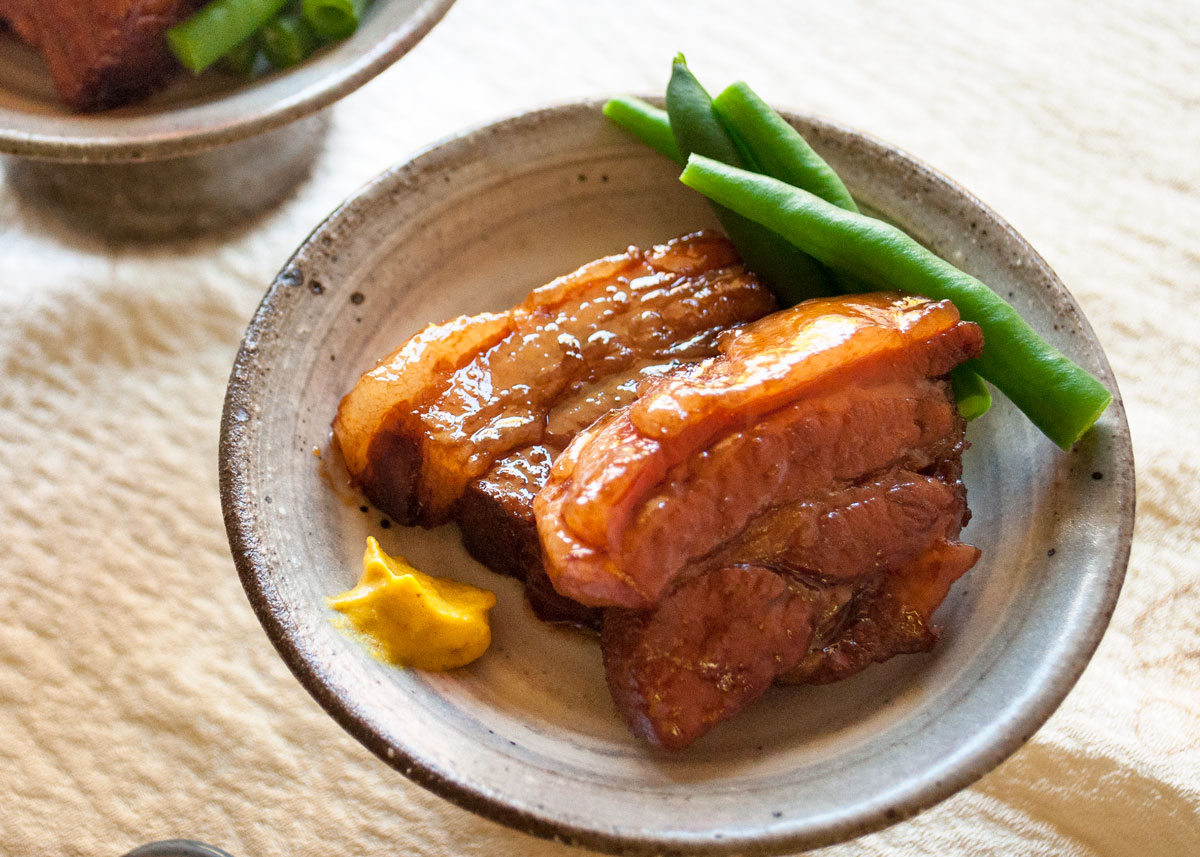
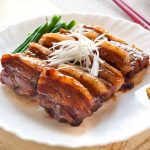
- 500g (1lb) pork belly (Note 1)
- 1 shallot/scallion stem , white part crashed (note 7)
- 30g (1oz) ginger , crashed (note 7)
- 100ml (3.foz) sake
- 100ml (3.foz) water
- 2 ½ tbsp soy sauce
- 2 tbsp sugar (Note 2)
- 6 green beans , boiled and cut into bite size
- 1 tbsp shallots , white part julienned (Note 3)
- Japanese karashi (Note4) or hot English mustard (optional)
-
Add the Pork ingredients in a large pot which is large enough to lay the pork belly strips. Add generous amount of water and turn the heat on high.
-
When the water starts boiling, reduce the heat to low so it simmers. Place a drop lid (Note 5) and cook for 2 hours or until tender (if the pork belly is thicker, you may need cook longer). If the water reduces too much and the pork appears above the water level, add some more water and ensure that the pork is always under the water.
-
Using tongs or two spatulas, remove the pork strips carefully from the pot and rinse them under the running cold water gently. The pork should be quite tender now so be careful not to break them.
-
Cut each pork belly strip into 3 or 4 equal sizes, about 4cm (1 1/2") wide.
-
The liquid in which the pork was boiled can be re-used as soup stock. See Note 6.
-
Add the Simmering Sauce ingredients and the pork belly pieces to another pot and turn the heat on high. When started boiling, reduce heat to low to simmer. Place a drop lid (Note 5) and cook for 25 minutes or until the liquid reduces to only about 1-2 tablespoons. While cooking, shake the pot occasionally to make sure that the sauce coats all sides of the meat.
-
Turn the heat off. Plate the pork with green beans on the side, add the julienned shallots on top. Drop a small amount of karashi or hot English mustard.
1. I had 3 strips of pork belly which were about 4cm (1 1/2") thick, 1.5cm (⅝") wide. They came with skin on but I removed the skin.
2. If you like sweeter flavour, you could increase the amount of sugar by ½ tablespoon.
3. Karashi is Japanese mustard. It is yellow paste just like most other mustard but it does not have acidity in it and very hot. You can buy karashi at Japanese/Asian grocery stores. It comes either in a tube as paste or in a tin as powder. To make karashi paste from powder, you mix the powder with warm water in a little bowl to form a paste, cover it with cling wrap for a while to develop spiciness.
3. I just took about 4 cm of the shallot stem (white part) from the Pork ingredients.
5. Drop lid (Otoshi buta - 落し蓋) is a round lid which is slightly smaller than the opening of a saucepan. It is traditionally made of wood but I have a stainless lid. It is placed on top of the ingredients in a pot to ensure the heat is evenly distributed, cook faster, make the ingredients stay in place without breaking apart. It also stops the liquid from evaporating quickly.
If you don’t have a drop lid, you can make one with aluminium foil. Cut a square foil, fold the edges to make it a round shape with the diameter slightly smaller than the port. Then poke the foil with a knife or a chopstick to make holes in several places.
Though using a drop lid is the traditional way of cooking Kakuni, you could just put a lid on the pot though this may affect how evenly the pork is braised.
6. Transfer the liquid in which the pork was boiled into a container through a sieve and leave it in the fridge. When chilled, remove the excess fat formed on the surface of the liquid. You can also freeze it.
7. Use the side of your knife to press down on the side of the shallots to crush the stem. Do the same for the ginger to crush.
Hello yumiko, I made this recipe today, but I think it did not go well. Although the taste was good, I assumed that it was not good because the meat was a bit difficult, that is, I do not think it could have been eaten with chopsticks, it was not tender as I expected. I have to mention that my pork belly was a little thick, that is, the layers of fat and meat were quite broad, could this have influenced?
Hi Ruth, the size of the pork strips makes a difference. I mentioned in the recipe notes that my belly was 4cm (1.5″) thick but this was a bit misleading as what I meant was the thickness of meat and fat layers and I did not mention the thickness of the belly strips. As you can see from the phots, thickness of strips was less than half of the layer thickness. The meat should be tender enough to easily bite off a piece. I will update the recipe to be more intuitive. Thanks for a note!
I’m in the process of making quite a bit of Kakuni right now. Using a french oven so not quite authentic but I just love the flavour.
Just a question – when you mention reserving the water as a sort of soup stock – what do u generally make with it? I was wondering if i could do a sort of ramen with the stock and some left over kakuni?
Hi Peter, you are spot on! The liquid has good pork flavour and I used it to make ramen. Adding kakuni would be perfect. I also used it for soup, by adding vegetables of my choice, salt, soy sauce to adjust the flavour.
If you think that the liquid is a bit too oily, you can chill it in the fridge to solidify the fat, remove the white fat of the surface.
This recipe is incredible! I made it with pork shoulder that I had left over instead of belly and it still turned out great. The fat really melts in your mouth!
Hi Aidan, the best part is the fat melting in your mouth, isn’t it? I should try making it with pork shoulder, too.
I just discover this, looks so good! Could I ask where can I buy sake for cooking in Sydney? thank you 🙂
Hi Shelly,
You can buy Japanese cooking sake at Coles and Woolworths as well as at most of Asian grocery stores. At Coles and Woolworths, for example, you will find Obento brand cooking sake (see the sample here: https://shop.coles.com.au/a/a-national/product/obento-cooking-sake) which is usually located in Asian isle. At Asian grocery stores, you will probably find Japanese brand cooking sake as well.
Please do not be confused with Chinese rice wine (usually much cheaper) as Chinese cooking rice wine has totally different flavour and does not go well with most Japanese cooking.
Hi,
I tried this recipe on Sat and I just want to tell you how amazing it is.
I used the stove so it took close to 3 hours to make it but so worth it when I took a bite.
The pork belly just melted in my mouth.
My only regret is not making a bigger batch so I can have leftovers.
Next time I make this I will make 3x the portions.
Thanks for sharing your recipes!
PS: I hastag the pic i took on instagram #recipetinjapan
Hi Josie. That’s great! I am glad that you liked it. That melting moment is special, isn’t it?
And I saw the photo on the instagram. Yay!
A very interesting way of cooking pork belly I really must try. I love the pork taste but cook only rarely because of health reasons. Here a lot of the fat would slowly cook away and since I do like my food to have depth of flavour I cannot imagine finding it too strong. As I work from home am lucky timewise: the kitchen is only two doors away from the office and I can both walk across to stir and wait for any length of time 🙂 !
Well, Eha. You are all set to cook kakuni, then! Good luck!
This looks delicious! I would like to try this in my new electric pressure cooker I purchased recently (I love it!). How long should it be cooked, and would it be on high or low pressure? Would you alter the liquid amount at all? Thanks!
Hi Naomi.
You would need to cook about 30 minutes on high but this is using my stove top pressure cooker.
You would also need to add extra water as water will evaporate in a form of steam while cooking. Depending on the pressure cooker, the amount of water required will vary. Using my pressure cooker, I added extra 250ml of water. The manual of your new pressure cooker might have some information on how much water it evaporates.
In any case, it is better to have too much water than too little. If too much, you can always cook extra without a lid to condense it but if too little water, it might burn before time is up.
Hi Yumiko, I have been following Nagi’s recipes for a while now, but just came across your blog. I love this Kakuni recipe as I do a very similar recipe, but will have to try yours next time. I love your story of your arrival here in Oz. and I must add here that I’ve traveled through Japan. The last time, hubby and I were cruising around the islands we were caught up in the tsunami that hit Fukashima (not sure of spelling now) but our ship was standing out in Tokyo Harbour waiting for the tsunami to pass, so we didn’t get in to see Tokyo at that time. I absolutely LOVE Japan and it’s people, they’re beautiful, gentle and so polite, but I do agree with you that it’s like a sea of heads. Thank you for sharing your wonderful cuisine, like mother – like daughter. I also love “Doser”.
Hi Josephine. Welcome! I hope you enjoy my recipes and sometimes try them. You were so lucky that your ship was not along the Tohoku coast lines. Just thinking gives me a shiver. You must go to Tokyo one day. It’s a great place for travellers, particularly the food lovers. And as you say, people are wonderful.
If you were making this recipe in a pressure cooker (like the Instant Pot) would you cook the meat the same, in water, and then cook it again on high with the simmering sauce ingredients afterward? If so, how long would that take? Asking so I can try it myself since I’m new to the pressure cooking world 🙂
Hi Beth, if using a pressure cooker, I would suggest that you cut the pork belly strips into serving chunks then cook in one go. Place them into the pressure cooker together with other ingredients including simmering sauce. And water to cover the pork and pressure cook for about 15-20 minutes. When the lid can be removed, simmer without the lid until the sauce reduces per the recipe. I have a pressure cooker but it is a cook top style, not an Instant Pot so I am not sure of the cooking duration (hence ranges). Good luck with it.
Hello Yumiko!
I enjoy your blog and your daughter’s as well! Thanks so much to you both for sharing your wonderful and delicious recipes! Can you please tell me how thick are your pork belly strips that you start out with? Many thanks!
Hi Marie,
The thickness of the pork belly was about 4cm which is 1 1/2″. It can be slightly less or more and it shouldn’t make much difference, although too thin would make the pork falling apart after boiling.
I should have mentioned the thickness of the pork. I will update the notes. Thanks for asking.
Thanks Yumiko! I’ll let you know how it turns out!!
Hi mum – I remember you making this in the pressure cooker when I we were kids! Though I wasn’t a fan of pork belly when I was younger, I LOVE it now. Love the strong flavours of this one!
I had little time to cook when kids were young so the pressure cooker was used a lot. Now I have a lot of time, as you always say :-), I don’t need to use it often.
That’s right you did not like fat of meat at all when you were little. You used to pick the fat and leave them on the side of the dining chair which attracted ants, remember? When I traced the marching line of the ants, I found it was you and you got in trouble. That is a funny story now but I was so angry at the time.
Nagi, You’re so funny. Loved the story of you disliking the fat and hiding it on the side of your chair. Kids will be kids no matter their age.
Konnichiwa Yumiko-san! This dish looks and sounds delicious! This pork is so juicy and even though it takes some time, the preparation is really quite simple. I have some pork belly in the freezer and I think I must try this very soon! Here in the US South pork belly is added in small pieces to pots of baked beans which are simmered for a long period of time.
Hi Dorothy-san. Kakuni is delicious! Please try and let me know how it was. Rice would go very well with it but bread would do well, too.